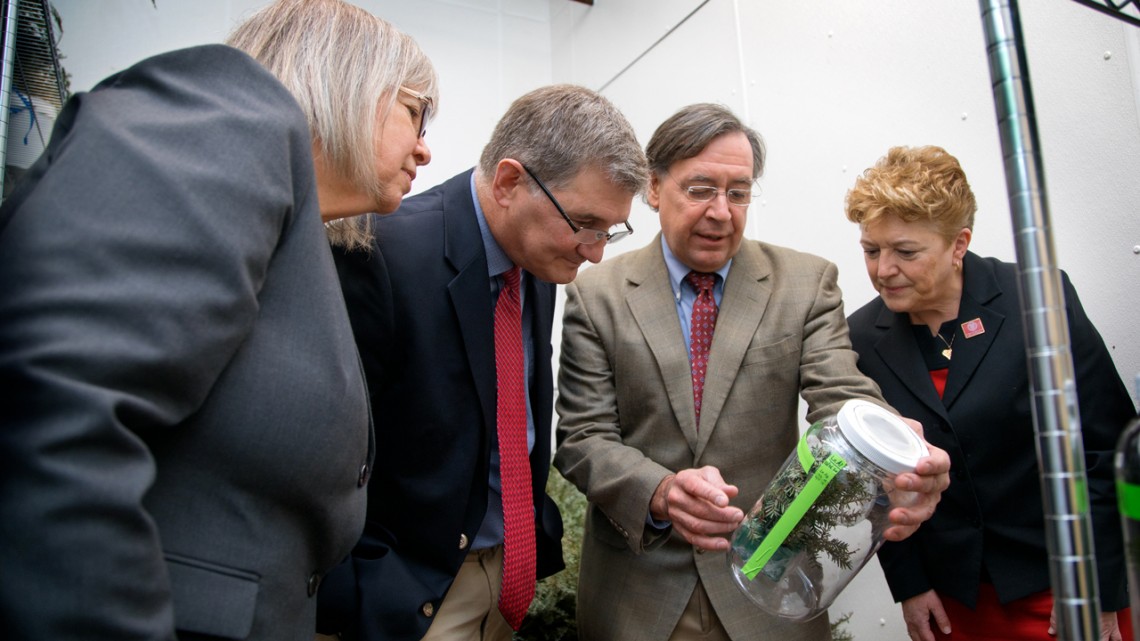
From left, Assemblywoman Barbara Lifton; Kenneth Lynch, executive deputy director of the New York State Department of Environmental Conservation; Mark Whitmore, forest entomologist at Cornell; and Kathryn J. Boor ‘80, the Ronald P. Lynch Dean of the College of Agriculture and Life Sciences, look at a container for rearing a Hemlock Woolly Adelgid in a Cornell lab.
Cornell, DEC launch new hemlock pest biocontrol lab
By Krishna Ramanujan
Cornell and the New York State Department of Environmental Conservation (DEC) announced the creation of a new biological control lab on campus to protect the state’s ecologically important hemlock trees.
The announcement of the $1.2 million lab, partly funded by the DEC with support from the state’s Environmental Protection Fund, was made at a ribbon-cutting ceremony Nov. 17.
The lab, headed by Cornell forest entomologist Mark Whitmore, will research and rear biological controls to slow the spread of hemlock woolly adelgids, invasive pests that threaten trees in roughly half of New York’s 62 counties and in more than 15 other states.
“Our team has been monitoring the spread of the hemlock woolly adelgid from our more southern states,” said Kathryn J. Boor ‘80, the Ronald P. Lynch Dean of the College of Agriculture and Life Sciences. “We’ve been preparing to meet the challenge of an invasive threat that, if left unchecked, will significantly impair water quality in our watersheds, particularly in the Catskills.”
Eastern hemlock trees are among the oldest trees in New York, with some more than 700 years old. The trees often occupy shady, north-facing slopes and stream banks and help maintain erosion control and water quality. Shade from the trees cools streams that are home to many of New York’s freshwater fish, including brook trout.
The hemlock woolly adelgid is a tiny insect native to the Pacific Northwest and East Asia. A Japanese variety was first discovered in New York in 1985. The pest attacks forest and ornamental hemlock trees, feeding on young twigs and causing buds to die and needles to dry out and drop prematurely. Hemlocks typically die within four to 10 years of adelgid infestation in the insect’s northern range.
Damage from the insect has led to widespread hemlock deaths throughout the Appalachian Mountains and the southern Catskills. Hemlock woolly adelgid infestations can be detected by the small, white, woolly masses produced by the insects that are attached to the undersides of twigs near the base of the needles.
Research has shown that Laricobius nigrinus beetles and silver flies, which both only prey on hemlock woolly adelgids, are effective biocontrol agents in the Pacific Northwest, where adelgids are native. The Cornell lab has been researching how effective these predators will be on invasive adelgids on the East Coast.
“We’ve gone through a lot of trial and error, but I think we have a productive solution now,” said Kenneth Lynch, executive deputy director of DEC. “And thanks to the investment in this lab by both Cornell and the state of New York, we’re moving the ball forward.”
Though colder temperatures generally slow the adelgid’s spread, offspring that survive cold winters build a more cold-tolerant population, which in turn puts colder regions such as the Adirondacks at greater risk. Recent mild winters have favored the spread of the pest in New York, said Whitmore, an extension associate in the Department of Natural Resources.
“Implementing biological control is basically a numbers game,” he said.
The possibility of releasing large numbers of biocontrol predators “greatly enhances the chances of successful establishment and it also enhances the possibility of the predator populations to grow more rapidly,” Whitmore said. “So that’s the purpose of this lab – to build the populations of predators so we can release them and hopefully they’ll become much more effective.”
Cornell and government partners first released L. nigrinus in 2009, and silver flies in 2015, both in small numbers in the state.
State Assemblywoman Barbara Lifton, D-125th District, also spoke at the event.
Media Contact
Get Cornell news delivered right to your inbox.
Subscribe